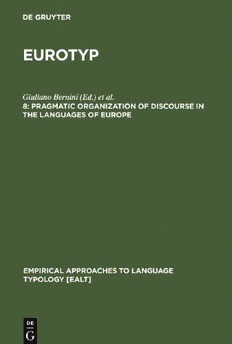
Eurotyp: Typology of Languages in Europe, Volume 8: Pragmatic Organization of Discourse in the Languages of Europe PDF
Preview Eurotyp: Typology of Languages in Europe, Volume 8: Pragmatic Organization of Discourse in the Languages of Europe
Pragmatic Organization of Discourse in the Languages of Europe ≥ Empirical Approaches to Language Typology urotyp E 20-8 Editors Georg Bossong Bernard Comrie Mouton de Gruyter Berlin · New York Pragmatic Organization of Discourse in the Languages of Europe edited by Giuliano Bernini Marcia L. Schwartz Mouton de Gruyter Berlin · New York MoutondeGruyter(formerlyMouton,TheHague) isaDivisionofWalterdeGruyterGmbH&Co.KG,Berlin. (cid:1)(cid:1)Printedonacid-freepaperwhichfallswithintheguidelinesofthe ANSItoensurepermanenceanddurability. LibraryofCongressCataloging-in-PublicationData PragmaticorganizationofdiscourseinthelanguagesofEurope/edited byGiulianoBernini,MarciaL.Schwartz. p.cm.(cid:1)(Empiricalapproachestolanguagetypology.EUROTYP; 20-8) Includesbibliographicalreferencesandindex. ISBN-13:978-3-11-015753-6(hardcover:alk.paper) ISBN-10:3-11-015753-5(hardcover:alk.paper) 1. Europe (cid:1) Languages. 2. Pragmatics. 3. Grammar, Compara- tive and general (cid:1) Syntax. 4. Discourse analysis. I. Bernini, Giuliano. II.Schwartz,MarciaL. III.Series. P380.P73 2006 306.44094(cid:1)dc22 2005031059 BibliographicinformationpublishedbyDieDeutscheBibliothek DieDeutscheBibliothekliststhispublicationintheDeutsche Nationalbibliografie;detailedbibliographicdataisavailableinthe Internetat(cid:2)http://dnb.ddb.de(cid:3). ISBN-13: 978-3-11-015753-6 ISBN-10: 3-11-015753-5 ©Copyright2006byWalterdeGruyterGmbH&Co.KG,D-10785Berlin. Allrightsreserved,includingthoseoftranslationintoforeignlanguages.Nopartofthisbook may be reproduced or transmitted in any form or by any means, electronic or mechanical, includingphotocopy,recordingoranyinformationstorageandretrievalsystem,withoutper- missioninwritingfromthepublisher. Typesetting:ChristophEyrich,Berlin. Printingandbinding:AZDruckundDatentechnikGmbH,Kempten(Allgäu). PrintedinGermany. (cid:1) (cid:1) v $Id:M-bernini.tex,v1.232006/06/0908:43:59eyrichExp$ |9/622:24|#1 (cid:1) (cid:1) The present volume is one of a series of nine volumes in which the results of the European research project “Typology of Languages in Europe” (EUROTYP) are published. The initiative for a European project on language typology came from aproposaljointlysubmittedtotheEuropeanScienceFoundation(ESF)byJohannes Bechert(UniversityofBremen),ClaudeBuridant(UniversityofStrasbourg),Martin Harris(UniversityofSalford,nowUniversityofManchester)andPaoloRamat(Uni- versityofPavia). On the basis of this proposal and following consultations with six experts the StandingCommitteefortheHumanitiesoftheESFdecidedtoorganizeaworkshop (Rome,January1988),inwhichthisideawasfurtherexploredanddeveloped.The resultsofthisworkshop(publishedbyMouton,1990)weresufficientlyencouraging for the Standing Committee toappoint a preparatorycommittee andentrustitwith thetasksofdrawingupapreliminaryproposal,ofsecuringinterestandparticipation from a sufficiently large number of scholars and of finding a suitable programme director. The project proposal formulated and sent out by Simon Dik (University of Amsterdam) as chair of this committee met with verysupportive andenthusias- ticreactions,sothattheStandingCommitteefortheHumanitiesrecommendedthe fundingofaplanningstageandtheGeneralAssemblyoftheESF approvedayear zero(1989)foranESFProgrammeinLanguageTypology. Duringthisplanningphaseallmajordecisionsconcerningthemanagementstruc- tureandtheorganisationoftheworkweretaken,i.e.,theselectionofaprogramme director,theselectionofninefocalareasaroundwhichtheresearchwastobeorga- nized, the selection of a theme coordinator for each theme and the selection of the advisorycommittee. Thefirsttaskoftheprogramme directorwastodrawupadefinitiveprojectpro- posal,whichwassupplementedwithindividualproposalsforeachthemeformulated bythethemecoordinators,andthisnewproposalbecamethebasisofadecisionby theESFtofundtheProgrammeforaperiodoffiveyears(1990–1994). Languagetypologyisthestudyofregularities,patternsandlimitsincrosslinguis- tic variation. The major goal of EUROTYP was to study the patterns and limits of variation in nine focal areas: pragmatic organization of discourse, constituent or- der, subordination and complementation, adverbialconstructions,tenseand aspect, nounphrasestructure,cliticsandwordprosodicsystemsinthelanguagesofEurope. The decision to restrict the investigation to the languages of Europe was imposed for purely practical and pragmatic reasons. In the course of the project an attempt wasmade,however,tomakeasmuchsenseofthisrestrictionaspossible,bychar- acterizing the specific features of European languages against the background of (cid:1) (cid:1) (cid:1) (cid:1) (cid:1) (cid:1) vi $Id:M-bernini.tex,v1.232006/06/0908:43:59eyrichExp$ |9/622:24|#2 (cid:1) (cid:1) vi GeneralPreface non-Europeanlanguagesandbyidentifyingarealphenomena(Sprachbünde)within Europe. Morespecifically,thegoalsoftheEUROTYPprojectincludedthefollowing: –tocontributetotheanalysisoftheninedomainssingledoutasfocalareas,toas- sesspatternsandlimitsofcross-linguisticvariationandtoofferexplanationsofthe patternsobserved. – to bring linguists from various European countries and from different schools or traditionsoflinguisticstogetherwithinamajorinternationalprojectonlanguagety- pologyandindoingsocreateanewbasisforfuturecooperativeventureswithinthe fieldoflinguistics. Morethan100linguists frommore than20Europeancountries andtheUnitedStatesparticipatedintheproject. – to promote the field of language typology inside and outside of Europe. More specifically,anattemptwasmadeto subjectto typologicalanalysisalarge number ofnewaspectsanddomainsoflanguagewhichwereunchartedterritorybefore. –toprovidenewinsightsintothespecificpropertiesofEuropeanlanguagesandthus contributetothecharacterizationofEuropeasalinguisticarea(Sprachbund). –tomakeacontributiontothemethodologyandthetheoreticalfoundationsoftypol- ogybydevelopingnewformsofcooperationandbyassessingtheroleofinductive generalization and the role of theory construction in language typology. We had a further, more ambitious goal, namely to make a contribution to lingustic theory by uncoveringmajor patterns of variationacrossanimportant subsetoflanguages,by providingalargetestinggroundfortheoreticalcontroversiesandbyfurtherdevelop- ingcertaintheoriesinconnectionwithavarietyoflanguages. Theresultsofourworkaredocumentedintheninefinalvolumes: PragmaticOrganizationofDiscourseintheLanguagesofEurope (editedbyG.Bernini) ConstituentOrderintheLanguagesofEurope(editedbyA.Siewierska) SubordinationandComplementationintheLanguagesofEurope (editedbyN.Vincent) ActanceetValencedansleslanguesdl’Europe(editedbyJ.Feuillet) AdverbialConstructionsintheLanguagesofEurope(editedbyJ.vanderAuwera) TenseandAspectintheLanguagesofEurope(editedbyÖ.Dahl) NounPhraseStructureintheLanguagesofEurope(editedbyF.Plank) CliticsintheLanguagesofEurope(editedbyH.vanRiemsdijk) WordProsodicSystemsintheLanguagesofEurope(editedbyH.vanderHulst) In addition, the EUROTYP Project led to a large number of related activities and publications,toonumeroustobelistedhere. At the end of this preface, I would like to express my profound appreciation to allorganizationsandindividualswhomadethisprojectpossible.Firstandforemost, I must mention the European Science Foundation, who funded and supported the (cid:1) (cid:1) (cid:1) (cid:1) (cid:1) (cid:1) vii $Id:M-bernini.tex,v1.232006/06/0908:43:59eyrichExp$ |9/622:24|#3 (cid:1) (cid:1) GeneralPreface vii Programme.Morespecifically,IwouldliketoexpressmyappreciationtoChristoph Mühlberg, Max Sparreboom and Geneviève Schauinger for their constant and ef- ficient support, without which we would not have been able to concentrate on our work.Iwould,furthermore,liketothankmycolleagueandformerassistant,Martin Haspelmath, and indeed all the participants in the Programme for their dedication and hard work. I finally acknowledge with gratitude the crucial role played by Jo- hannes Bechert and Simon Dik in getting this project off the ground. Their illness anduntimelydeathsdeprivedusalloftwooftheproject’smajorinstigators. EkkehardKönig,ProgrammeDirector (cid:1) (cid:1) (cid:1) (cid:1) (cid:1) (cid:1) viii $Id:M-bernini.tex,v1.232006/06/0908:43:59eyrichExp$ |9/622:24|#4 (cid:1) (cid:1) (cid:1) (cid:1) (cid:1) (cid:1) (cid:1) (cid:1) ix $Id:M-bernini.tex,v1.232006/06/0908:43:59eyrichExp$ |9/622:24|#5 (cid:1) (cid:1) Contents GeneralPreface . . . . . . . . . . . . . . . . . . . . . . . . . . . . . . . . . v Contributors . . . . . . . . . . . . . . . . . . . . . . . . . . . . . . . . . . . xxiii I. Generalissue GiulianoBernini Introduction . . . . . . . . . . . . . . . . . . . . . . . . . . . . . . . . . . . 3 JimMillerandM.M.JocelyneFernandez-Vest Spokenandwrittenlanguage . . . . . . . . . . . . . . . . . . . . . . . . . . 9 II. Fromfunctiontoform ElenaMaslovaandGiulianoBernini SentencetopicsinthelanguagesofEuropeandbeyond . . . . . . . . . . . . 67 JimMiller FocusinthelanguagesofEurope . . . . . . . . . . . . . . . . . . . . . . . . 121 YaronMatrasandA.MachteltBolkestein Deixisandanaphora:Somecasestudies . . . . . . . . . . . . . . . . . . . . 215 Hans-JürgenSasse Theticity . . . . . . . . . . . . . . . . . . . . . . . . . . . . . . . . . . . . . 255 III. Fromformtofunction AlanCruttenden Thede-accentingofgiveninformation:Acognitiveuniversal? . . . . . . . . 311 RosannaSornicola Interactionofsyntacticandpragmaticfactorsonbasicwordorderinthe languagesofEurope. . . . . . . . . . . . . . . . . . . . . . . . . . . . . . . 357 ChristophSchroeder ArticlesandarticlesystemsinsomeareasofEurope . . . . . . . . . . . . . . 545 (cid:1) (cid:1) (cid:1) (cid:1)
